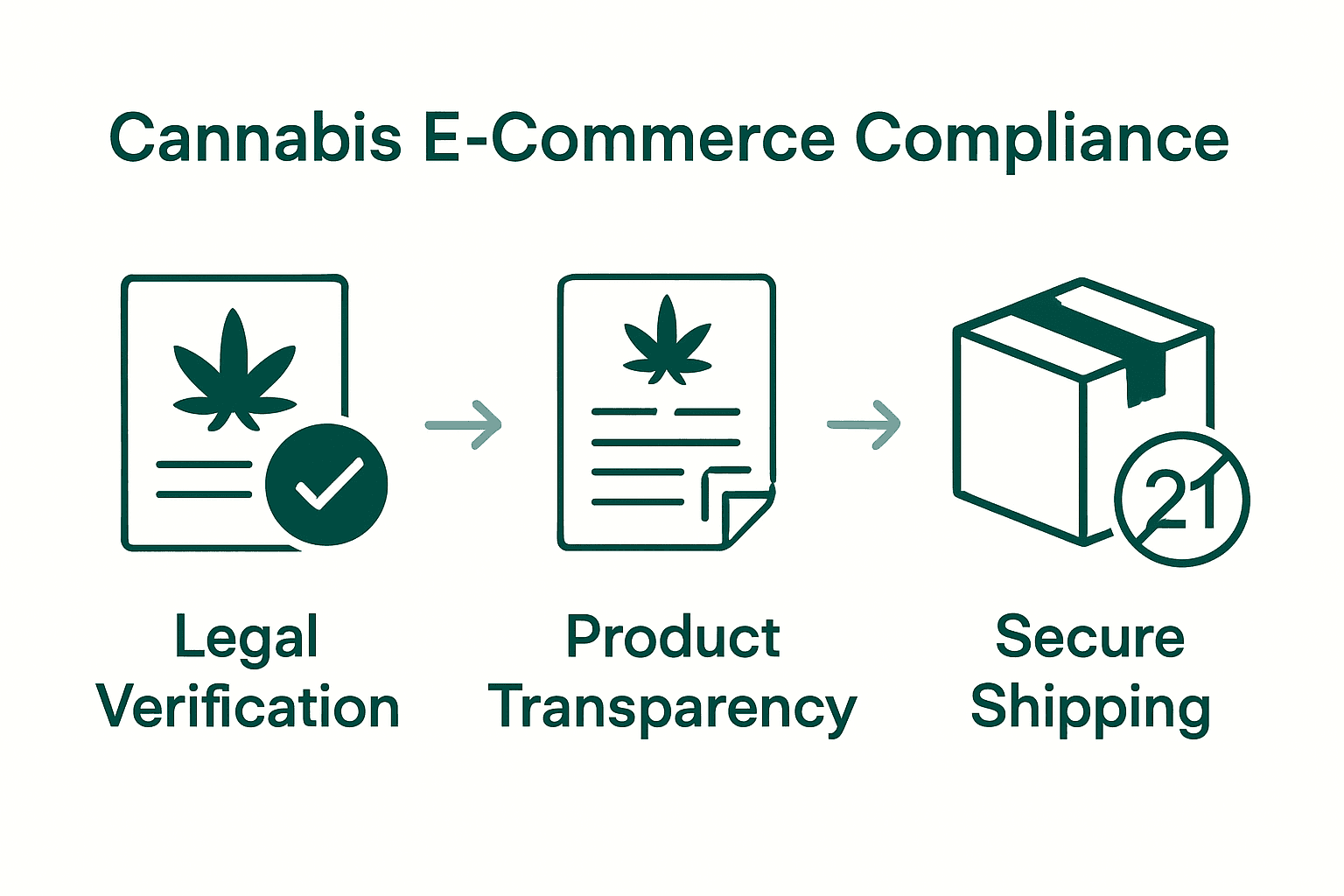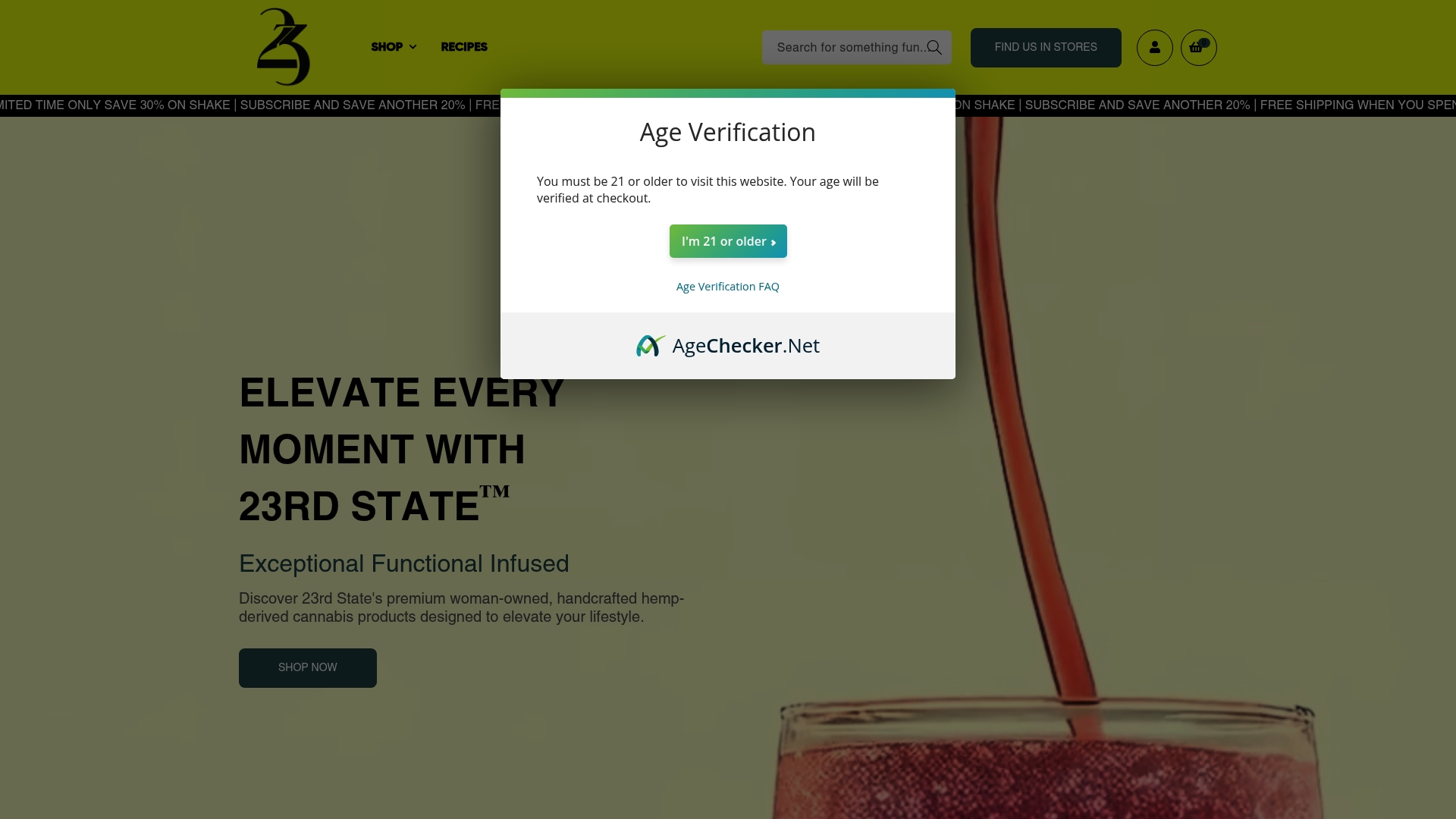Nearly $30 billion in legal cannabis sales were recorded in the United States in 2023. That growth brings huge opportunity for entrepreneurs, but it also comes with complex rules that can make or break a new business. Understanding how to set up a compliant cannabis e-commerce operation will help you move forward with confidence while building a business that stands out for its professionalism and trustworthiness.
Quick Summary
| Key Point | Explanation |
|---|---|
| 1. Ensure Products Meet THC Limit | Products must contain no more than 0.3% delta-9 THC to comply with federal laws. |
| 2. Obtain U.S. Hemp Authority Certification | This certification validates quality and manufacturing practices, enhancing consumer trust and industry credibility. |
| 3. Implement Strong Security and Tracking | Meticulous tracking of product batches and supplier licenses is essential for compliance and operational integrity. |
| 4. Select Compliant E-Commerce Platforms | Choose platforms designed for cannabis sales, featuring security, compliance tracking, and age verification tools. |
| 5. Maintain Detailed Shipping Documentation | Comprehensive records for THC levels and age verification are required for legal and safe shipping of products. |
Table of Contents
- Step 1: Set Up Legal Compliance And Licensing
- Step 2: Select And Configure Your E-Commerce Platform
- Step 3: Design Compelling Product Listings And Categories
- Step 4: Implement Promotions And Customer Engagement Tools
- Step 5: Verify Order Fulfillment And Shipping Processes
Step 1: Set Up Legal Compliance and Licensing
Navigating legal compliance for cannabis e-commerce requires strategic planning and meticulous attention to regulatory details. In this step, you will learn how to establish a legally sound foundation for your hemp and THC online business by understanding federal requirements and obtaining necessary certifications.
Starting with federal guidelines, the 2018 Farm Bill provides critical baseline standards for hemp product sales. According to federal requirements, your products must contain no more than 0.3% delta-9 THC to remain compliant. This means carefully tracking THC concentration in every product batch and maintaining comprehensive documentation.
To demonstrate your commitment to quality and regulatory standards, consider pursuing the U.S. Hemp Authority® Certification. This rigorous third-party audit process helps businesses validate their adherence to quality management, good manufacturing practices, and truth-in-labeling standards. The certification not only enhances consumer confidence but also signals to retailers that your operation meets professional industry benchmarks.
Pro Tip: Always maintain comprehensive Certificates of Analysis (COAs) for each product batch and keep digital copies readily accessible for potential regulatory reviews.
Key compliance steps include:
Here’s a summary of essential compliance actions for your cannabis e-commerce setup:
| Compliance Requirement | Description | Importance |
|---|---|---|
| Federal THC Limit | ≤ 0.3% delta-9 THC per product | Mandatory |
| Supplier License Verification | Confirm all suppliers are licensed | High |
| Batch Tracking & Documentation | Meticulous product batch records | High |
| Certificates of Analysis (COAs) | COA for each product batch Digital copies accessible |
Critical |
| U.S. Hemp Authority® Certification | Third-party quality certification | Recommended |
| Security Protocols | Secure inventory management | High |
| THC Level Documentation | Track and log concentrations | Mandatory |
- Verify supplier licenses for all hemp and THC products
- Track batch records meticulously
- Implement robust security protocols for inventory management
- Maintain detailed documentation of THC concentration levels
By proactively establishing these compliance mechanisms, you create a solid legal framework that protects your business and builds trust with consumers and regulatory bodies. Your next step will involve setting up secure payment processing and banking relationships that align with these compliance standards.
Step 2: Select and Configure Your E-Commerce Platform
Choosing the right e-commerce platform is crucial for launching a successful online cannabis business. In this step, you will learn how to select a platform that supports hemp and THC product sales while providing robust features for your digital storefront.
When exploring platform options, look for solutions specifically designed to support hemp and CBD merchants. According to research, platforms like BigCommerce have expanded their services to support legally operating U.S. CBD and hemp merchants, offering compliant storefronts specifically tailored for hemp-derived product sales.
Your ideal platform should provide several key features critical for cannabis e-commerce. These include age verification systems, secure payment processing capabilities, inventory management tools, and compliance tracking mechanisms. Pay special attention to platforms that understand the unique regulatory landscape of hemp and THC product sales.
Pro Tip: Always verify the platform’s specific policies regarding hemp and cannabis products before committing to ensure full compliance with current regulations.
Key considerations for platform selection include:
- Robust age verification protocols
- Integrated compliance documentation management
- Secure payment gateway options
- Mobile responsive design
- Scalable infrastructure
Beyond technical features, consider the platform’s customer support quality and their experience with cannabis industry specific challenges. A platform with dedicated support can help you navigate complex regulatory requirements and technical implementation smoothly. Your next step will involve setting up your product catalog and configuring detailed compliance settings within your chosen e-commerce environment.
Step 3: Design Compelling Product Listings and Categories
Creating standout product listings is your gateway to capturing customer attention and ensuring regulatory compliance in cannabis e-commerce. This step will guide you through developing product descriptions and category structures that are both legally sound and marketing attractive.
Transparency is the cornerstone of effective product listings in the cannabis market. According to research from cannabis merchant solutions, your product pages must include critical information such as total CBD amounts, per-serving quantities, precise THC content, complete ingredient lists, batch numbers, and expiration dates. Avoid making unsubstantiated health claims that could trigger regulatory scrutiny from the FDA.
When designing your product categories, think about how customers search and explore cannabis products. Group items logically based on attributes like cannabinoid profile, consumption method, potency levels, and intended effects. This approach helps customers quickly find exactly what they need while demonstrating your commitment to clear, user-friendly presentation.
Pro Tip: Include clear visual representations of required regulatory symbols and packaging information to build immediate trust with potential buyers.
Key elements for each product listing should encompass:
- Exact THC and CBD content percentages
- Manufacturer information
- Unique batch tracking number
- Clear serving size recommendations
- Prominent health risk statements
- High resolution product images
By meticulously crafting your product listings with both creativity and compliance in mind, you establish a professional online presence that speaks directly to informed cannabis consumers. Your next step involves implementing robust age verification and checkout processes that complement these detailed product presentations.

Step 4: Implement Promotions and Customer Engagement Tools
Developing strategic promotions and customer engagement tools is essential for standing out in the competitive cannabis e-commerce landscape. This step will guide you through creating marketing approaches that attract customers while maintaining strict regulatory compliance.
Leveraging marketing technology specifically designed for the cannabis industry can dramatically improve your customer outreach. According to research about Leafbuyer, specialized marketing platforms enable cannabis businesses to develop targeted deals and engagement strategies that work within complex regulatory environments.
Your promotional strategy should focus on creating value for customers while navigating legal restrictions. This means designing offers that highlight product quality, educational content, and unique customer experiences rather than relying on traditional aggressive marketing tactics. Consider implementing loyalty programs, educational workshops, and personalized communication that builds long-term customer relationships.
Pro Tip: Always ensure your promotional materials include clear age verification requirements and avoid making any unsubstantiated health claims.
Effective engagement tools for cannabis e-commerce include:
- Email marketing with segmented customer lists
- Educational content about product usage and benefits
- Personalized recommendation systems
- Virtual consultation scheduling
- Transparent loyalty reward programs
By thoughtfully integrating these engagement strategies, you create a customer experience that feels personalized, informative, and trustworthy. Your next step involves developing a comprehensive customer support framework that complements these promotional efforts.
Step 5: Verify Order Fulfillment and Shipping Processes
Mastering order fulfillment and shipping is critical for building customer trust and maintaining regulatory compliance in cannabis e-commerce. This step will guide you through establishing robust processes that ensure your products reach customers safely and legally.
According to research from ShipBob, shipping hemp products requires meticulous attention to federal guidelines. Products must contain 0.3% or less delta-9 THC to be legally shipped nationwide via major carriers. This means carefully documenting and verifying THC concentrations for every single shipment.
Navigating shipping regulations demands a comprehensive understanding of carrier policies. The United States Postal Service permits shipping hemp-based products if you retain shipping documentation for two years. However, major carriers impose strict requirements mandating full compliance with federal, state, and local laws. Critically, cross-state shipping of products with higher THC levels remains prohibited.
Pro Tip: Maintain comprehensive paperwork for each shipment, including detailed certificates of analysis, to demonstrate regulatory compliance and protect your business.
Key considerations for shipping cannabis products include:
- Precise THC concentration tracking
- Age verification for recipient
- Secure packaging protocols
- Detailed shipping documentation
- Carrier-specific compliance guidelines
By developing a systematic approach to order fulfillment, you create a seamless customer experience that prioritizes legal compliance and product integrity. Your next step involves implementing robust tracking and customer communication systems to support these shipping processes.

Ready to Simplify Cannabis E-Commerce? Discover a Seamless Solution
Are you struggling to navigate the complex world of cannabis e-commerce, from compliance and secure payment setup to transparent product listings and fast shipping? If building trust, boosting consumer confidence, and staying ahead of regulations are your top concerns, let your expertise shine by partnering with a platform that already checks all the boxes. Our CBD collection offers handpicked hemp-derived products with full batch tracking, Certificates of Analysis, and detailed compliance data—exactly what your customers and regulators expect.

Take the next step toward stress-free sales. Explore https://23state.com for solutions built for the unique demands of hemp and THC e-commerce. Elevate your store, unlock exclusive offers, and keep your operations compliant with premium CBD products and curated garnishes. Now is the time to make selling hemp and THC online easier and more rewarding. Visit us and see how smooth and secure cannabis commerce can be.
Frequently Asked Questions
What are the key legal compliance requirements for selling hemp and THC online?
To legally sell hemp and THC products online, ensure that your products contain no more than 0.3% delta-9 THC, verify supplier licenses, and maintain thorough batch tracking and documentation. Start by obtaining comprehensive Certificates of Analysis (COAs) for each product batch to support compliance and consumer trust.
How do I choose the right e-commerce platform for my cannabis business?
Select an e-commerce platform that specifically supports hemp and THC product sales, offering features like age verification, secure payment processing, and compliance tracking. Research platforms that cater to the cannabis industry and prioritize those with responsive customer support and relevant experience.
What essential elements should I include in my cannabis product listings?
Your product listings should feature exact THC and CBD content percentages, unique batch tracking numbers, serving size recommendations, and complete ingredient lists. Aim for clarity and transparency to build trust with consumers and avoid unsubstantiated health claims that could lead to regulatory issues.
What are effective promotional strategies for engaging cannabis consumers?
Develop promotions that focus on educating customers about your products while remaining compliant with legal restrictions. Consider implementing loyalty programs, personalized communication, and educational workshops that enhance customer relationships and build brand loyalty.
How can I ensure regulatory compliance during order fulfillment and shipping?
To ensure compliance, meticulously track THC concentrations, maintain detailed shipping documentation, and follow carrier-specific policies for hemp products. Create a standard operating procedure for packaging and shipping that includes age verification for recipients and secure packaging protocols to protect your products.
What role does maintaining Certificates of Analysis (COAs) play in cannabis e-commerce?
Maintaining COAs for each product batch is critical for demonstrating compliance with legal standards and assuring customers of product quality. Keep these certificates readily accessible to streamline regulatory reviews and enhance transparency.

